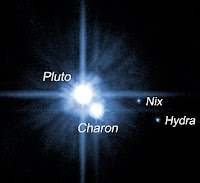I would like to introduce a new hobby: It's called Exogazing.
Exogazing is like stargazing, except that aside from gazing at the stars, you also gaze at exoplanets. Well, you don't really see the actual exoplanets, but in theory the photons of light that grazed past a transiting exoplanet's atmosphere might reach your eyes. Because as you gaze at a star that hosts a transiting exoplanet, the photons of light that contain some information about the exoplanet may make it to your retina. But too little amount of these photons is not enough for our eyes to perceive it. Most of what our eyes see is the star (but with much better instruments to collect light, you can find out more about an exoplanet's atmosphere--as what scientists do, with the method called Photometry) Exogazing is simple and requires minimal instruments. Anyone can do it.
Exogazing is a contraction of the phrase "Extrasolar Gazing", a term in line with the usual "stargazing". In essence when we look up in the night sky, we are mostly gazing at objects
outside our solar system. But "exogazing" is deliberately identifying the location of an exoplanet in the night sky as a pinpoint of light by it's host star.
Exogazing also comes from "Exoplanet Gazing", a term indicative of the wonder and fascination of Extrasolar Worlds. But in relation to actual planet-hunting which involves trying to detect yet-undiscovered planets around other stars, Exogazing is simply gazing at star-filled constellations and "spotting" for which stars have known exoplanets orbiting around it. Exogazing can be considered as a step prior to Exoplanet Observing.
Inspiration.
When the discovery of
Fomalhaut b via Direct Imaging came about, I was inspired. To look upon a star, knowing that there is a planet orbiting around it, gives me that
Exoplanetary Thinking effect.
The idea of being able to point at a star visible to the naked eye, and tell others about its planets has got me hooked. I love telling my kids about these exoplanets as I point toward their direction in the night sky--at the actual host star, in a familiar constellation. And I would love to stir their imagination about other worlds. What better connection to a young mind than to actually stand beside a child and then point at an actual star with a confirmed planet orbiting around it? It's Astronomy, Science, Imagination, and Inspiration at it's best!
The Method.
To identify and pinpoint the actual star that hosts the exoplanet is the basic task of Exogazing. It's simple. It starts with a simple question, "Which stars have confirmed exoplanets?" Then a little challenge of star-hopping and occasional use of "pointers" makes it all the more fun. Heck, you might even come up with your own directional pointers specific to exogazing.
Currently, there are only few stars visible to the naked eye that have confirmed exoplanets. But a number of some exoplanet-hosting stars are quite faint thus you need a binocular and a starchart to locate them in the sky. Star-hopping is often necessary to avoid getting lost in your field of view. And once you locate the star that hosts the exoplanet, let your eyes gaze upon it for a while and feel free to enjoy the wonderful moment of knowing the fact that this particular pinpoint of light reaching your eyes contain other worlds.
Other Benefits.
Exogazing is a good hobby to allow you familiarize oneself with the stars and constellations, or Astronomy in general. Having a goal in mind, such as trying to locate faint stars which host planets stimulates learning, and enhances information-retention.
And for hopeful amateur astronomers who may eventually join the ranks of that amateur group who will someday contribute to the discovery of new exoplanets, Exogazing is a perfect introductory activity to get familiarized with planet-hunting or exoplanet observing.
Basic Instruments.
Now what instruments do you need for exogazing?
Here are the basics:
Planisphere, starcharts, binoculars, music.
Exogazing Music - I value the human experience, and you need to experience the wonder of the stars. Music is a much-needed factor to complete the experience. I highly recommend songs that have no lyrics, so as to let the stars sing to you in their own "voices". The genre of post-rock or electronic chill works best for me to get that mood and "spiritual" experience. [UPDATE: A new genre has sprouted from this: It's called "Exogazing" music] Besides, there should be a reason why star-parties are called the way it is, so i think Music should definitely be a part of it.
Star Catalogs - Some more challenging stars that are too faint, may require you to consult a more detailed catalog of stars.
Optional Instruments.
Tripod-mounted binoculars would be great but if you want an enhanced experience, an Image Stabilized (IS) binocular will be a great option. Part of the telling factor of exogazing is the human experience. The image stabilization feature eliminates the jittering and makes exogazing a wonderful experience, specially when you often need to pan to-and-fro across the sky as you "star hop" to make your way to the target. So the agility of hand-held binoculars are highly-recommended.
Laptop - You might need it to access updated information about the exoplanets you are gazing at, or to consult astronomy software such as Stellarium or Google Sky. As an option, you may need it to contribute your findings to the open database at Freebase, or to connect to last.fm to play the recommended exogazing music. :)
Green laser pointer - For helping others star-hop in the sky & Instructional purposes
Red flashlight - For checking charts in the dark and preserving night vision
Basic questions.
You need a few basic questions to get you going, which starts with "Where are those doggone Exoplanets?" The rest will follow: What constellations are up tonight? And which visible stars within those constellations have confirmed exoplanets? What are the exoplanets that belong to a particular constellation? What is the type of star of a particular exoplanet? What type of exoplanet is it? How far is it? Is it habitable?
Future.
There will be more Exoplanets to come. And so Exogazing will become ever more fun in the near future. May it serve as the start of a fun new activity for all Astronomers (Amateurs and Professionals alike) in their stargazing nights. And I hope that the Amateur Astronomy community would love Exogazing during star-parties as well!
I will continue to share my Exogazing sessions and open up a section in the
Exoplanetology website dedicated for this hobby. I will also continue to tweet and write about it in this blog. So stay tuned!
Happy Exogazing! And Clear skies!
 As everyone knows, Pluto is no longer considered a planet by the IAU. Why? Because some folks decided that a planet must satisfy three conditions to be considered as a planet:
As everyone knows, Pluto is no longer considered a planet by the IAU. Why? Because some folks decided that a planet must satisfy three conditions to be considered as a planet:





